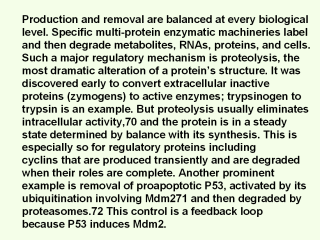| front |1 |2 |3 |4 |5 |6 |7 |8 |9 |10 |11 |12 |13 |14 |15 |16 |17 |18 |19 |20 |21 |22 |23 |24 |25 |26 |27 |28 |29 |30 |review |
 |
Another level of
regulation by liability is the removal of mRNAs, balanced by their transcriptions. For cells also, proliferation is balanced by loss which can be caused by an organized series of molecular steps termed Programmed Cell Death (apoptosis), often reviewed see ref. 57. A key to this complex process is the apoptosis activating tumor suppressor p53 protein. It is very frequently inactivated in cancers. Another antiapoptotic molecule is the transcription factor NF-kB, constitutively elevated in many cancers. Its activation provides an example of the complexity of regulation. NF-kB is usually as an inactive protein dimer combined with an inhibitory protein IkB, and is located in the cytoplasm. An activated kinase cascade causes phosphorylation of IkB and releases it from NF-kB, followed by proteolytic degradation. The freed NF-kB relocalizes, moving into the nucleus where it itself is phosphorylated and binds to DNA motifs to activate over 100 transcriptions. Furthermore a feedback control is brought into play by NF-vB’s transcription of IkB, the inhibitor of its activation.73 |